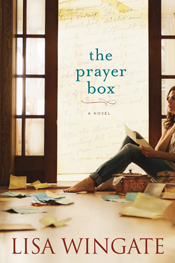Wingate, Lisa. The Prayer Box. Tyndale House Publishers, 2013. 400pp. Softcover: $15.99, ISBN: 978-1-4143-8688-1; Hardcover: $19.99, ISBN: 978-1-4143-8825-0; eBook: $15.99, ISBN: 978-1-4143-8721-5.
Tandi Jo is a muddled young mother who escaped from a destructive
relationship with her two children and few belongings, and—by God’s grace—landed
in Iola Anne’s cottage where she is detoxing from dependence upon painkillers
and slowly returning to the world of the living. Desperate for income yet
striving to maintain anonymity, Tandi is blessed with the opportunity to clean
up Iola Anne’s house in exchange for continued rent.
A collection of eighty-one intricately-decorated boxes stacked in the closet of Iola Anne’s bedroom turns out to be the repository of a lifetime of letters to God. While emerging from years of stupor, Tandi explores the contents of these private prayer boxes and is engrossed as Iola Anne’s amazing life story is gradually revealed.
This heartwarming tale of self-discovery, grace and redemption
artfully unfolds along the Atlantic shore, introducing myriad complex
characters whose beauty the rightfully long-suspicious Tandi Jo learns to appreciate
as Iola Anne’s words and God’s lessons help her to find grace and love again in
the world around her.A collection of eighty-one intricately-decorated boxes stacked in the closet of Iola Anne’s bedroom turns out to be the repository of a lifetime of letters to God. While emerging from years of stupor, Tandi explores the contents of these private prayer boxes and is engrossed as Iola Anne’s amazing life story is gradually revealed.
Already familiar with and enamored of the concept of prayer boxes from having read August Gold and Joel Fotinos’s spiritual parable The Prayer Chest, and having begun to share copies of that novel with dear friends, I was eager to meet Wingate’s visualization of the concept; however, I was totally unprepared for the sheer beauty of Wingate's The Prayer Box. This novel is a not-to-be-missed treasure, and one that I will enclose in years to come in the boxes I give to those special persons with whom I share the gift of the concept of writing letters/prayers to God then tucking them away, turning them over to God for safekeeping, and not dwelling upon them ourselves.
Cynthia Winfield
grateful reader











